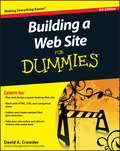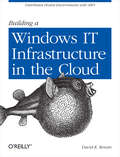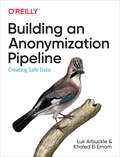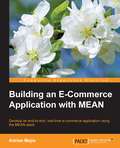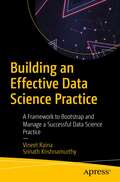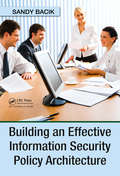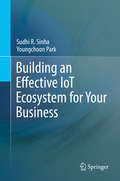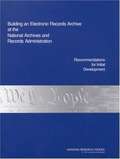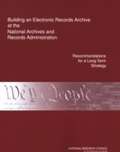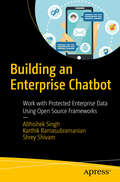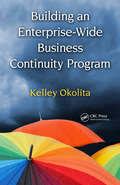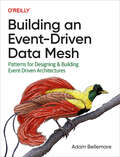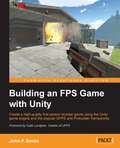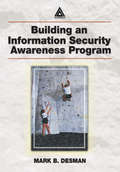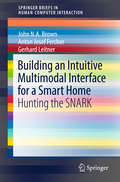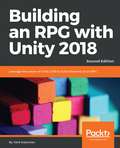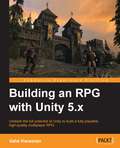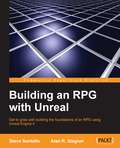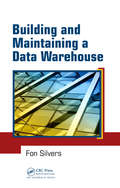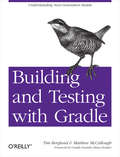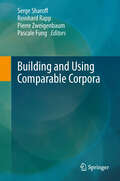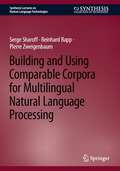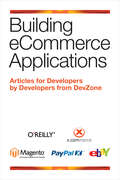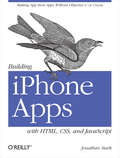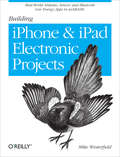- Table View
- List View
Building a Web Site For Dummies
by David A. CrowderThe bestselling guide to building a knockout Web site, newly updatedAn effective Web site is the key to success for every venture from class reunions to major corporations. And since Web technology changes rapidly, Building a Web Site For Dummies, 4th Edition is fully updated for the cutting-edge tools and trends.If you need to build and maintain a Web site, even if your experience is severely limited, this book makes it easy and fun. You'll learn to plan, design, create, launch, and maintain your site using the most up-to-date tools.A quality Web presence is essential in today's marketplace, and many individuals charged with creating one are unaware of the challengesThis guide gives novice Web designers the tools and know-how to plan, design, and build effective Web sitesProvides a nuts-and-bolts guide to site-building, including coverage of HTML, WYSIWYG construction software, CSS, and navigation plansShows how to spruce up your site with topnotch graphics, video, and great contentGuides you through getting your site online, promoting it, and even making money from itBuilding a Web Site For Dummies, 4th Edition is the tool every first-time Web designer needs to build a professional-looking site.
Building a Windows IT Infrastructure in the Cloud: Distributed Hosted Environments with AWS
by David K. RensinRun your entire corporate IT infrastructure in a cloud environment that you control completely—and do it inexpensively and securely with help from this hands-on book. All you need to get started is basic IT experience.You’ll learn how to use Amazon Web Services (AWS) to build a private Windows domain, complete with Active Directory, enterprise email, instant messaging, IP telephony, automated management, and other services. By the end of the book, you’ll have a fully functioning IT infrastructure you can operate for less than $300 per month.Learn about Virtual Private Cloud (VPC) and other AWS tools you’ll useCreate a Windows domain and set up a DNS management systemInstall Active Directory and a Windows Primary Domain ControllerUse Microsoft Exchange to set up an enterprise email serviceImport existing Windows Server-based virtual machines into your VPCSet up an enterprise-class chat/IM service, using the XMPP protocolInstall and configure a VoIP PBX telephony system with Asterisk and FreePBXKeep your network running smoothly with automated backup and restore, intrusion detection, and fault alerting
Building an Anonymization Pipeline: Creating Safe Data
by Luk Arbuckle Khaled El EmamHow can you use data in a way that protects individual privacy but still provides useful and meaningful analytics? With this practical book, data architects and engineers will learn how to establish and integrate secure, repeatable anonymization processes into their data flows and analytics in a sustainable manner.Luk Arbuckle and Khaled El Emam from Privacy Analytics explore end-to-end solutions for anonymizing device and IoT data, based on collection models and use cases that address real business needs. These examples come from some of the most demanding data environments, such as healthcare, using approaches that have withstood the test of time.Create anonymization solutions diverse enough to cover a spectrum of use casesMatch your solutions to the data you use, the people you share it with, and your analysis goalsBuild anonymization pipelines around various data collection models to cover different business needsGenerate an anonymized version of original data or use an analytics platform to generate anonymized outputsExamine the ethical issues around the use of anonymized data
Building an E-Commerce Application with MEAN
by Adrian MejiaDevelop an end-to-end, real-time e-commerce application using the MEAN stack About This Book * Build all the main components of an e-commerce website and extend its high-quality features as per your needs * Get to grips with the full-stack JavaScript to build attractive e-commerce sites and start making money * A step-by-step guide to developing the MEAN stack components from scratch to achieve maximum flexibility when building an e-commerce application Who This Book Is For This book is for a web or full stack JavaScript developer who wants to get a head start on developing an e-commerce application with MEAN. A basic knowledge of the MEAN stack is highly recommended. What You Will Learn * Employ AngularJS to build responsive UI components * Implement multiple authentication strategies such as OAuth, JsonWebToken, and Sessions * Enhance website usability with social logins such as Facebook, Twitter, and Google * Create integrations with payment platforms such as PayPal * Apply full-text search functionality in MongoDB * Build a flexible categorization system to organize your products * Secure your app by creating SSL certificates and run payment platforms in a live environment In Detail MEAN stands for MongoDB, Express, AngularJS, and Node.js. It is a combination of a NoSQL database, MongoDB, with a couple of JavaScript web application frameworks, namely Express.js and Angular.js. These run on Node.js. There is always an ever-growing list of requirements while designing an e-commerce application, which needs to be flexible enough for easy adaptation. The MEAN stack allows you to meet those requirements on time and build responsive applications using JavaScript. This book will show you how to create your own e-commerce application using the MEAN stack. It will take you step by step through the parallel process of learning and building. It will also teach you to develop a production-ready, high-quality e-commerce site from scratch and will provide the knowledge you need to extend your own features to the e-commerce site. This book starts with a short introduction to the MEAN stack, followed by a step-by-step guide on how to build a store with AngularJS, set up a database with MongoDB, create a REST API, and wire AngularJS. It also shows you how to manage user authentication and authorization, check multiple payment platforms, add products' search and navigation, deploy a production-ready e-commerce site, and finally add your own high-quality feature to the site. By the end of the book, you will be able to build and use your own e-commerce app in the real world and will also be able to add your own new features to it. Style and approach This book is a step-by-step guide on how to build a real-time e-commerce app with MEAN. Each transition is well explained, and each chapter begins with the required background knowledge.
Building an Effective Data Science Practice: A Framework to Bootstrap and Manage a Successful Data Science Practice
by Vineet Raina Srinath KrishnamurthyGain a deep understanding of data science and the thought process needed to solve problems in that field using the required techniques, technologies and skills that go into forming an interdisciplinary team. This book will enable you to set up an effective team of engineers, data scientists, analysts, and other stakeholders that can collaborate effectively on crucial aspects such as problem formulation, execution of experiments, and model performance evaluation.You’ll start by delving into the fundamentals of data science – classes of data science problems, data science techniques and their applications – and gradually build up to building a professional reference operating model for a data science function in an organization. This operating model covers the roles and skills required in a team, the techniques and technologies they use, and the best practices typically followed in executing data science projects.Building an Effective Data Science Practice provides a common base of reference knowledge and solutions, and addresses the kinds of challenges that arise to ensure your data science team is both productive and aligned with the business goals from the very start. Reinforced with real examples, this book allows you to confidently determine the strategic answers to effectively align your business goals with the operations of the data science practice. What You’ll Learn Transform business objectives into concrete problems that can be solved using data scienceEvaluate how problems and the specifics of a business drive the techniques and model evaluation guidelines used in a projectBuild and operate an effective interdisciplinary data science team within an organizationEvaluating the progress of the team towards the business RoIUnderstand the important regulatory aspects that are applicable to a data science practice Who This Book Is For Technology leaders, data scientists, and project managers
Building an Effective Information Security Policy Architecture
by Sandy BacikInformation security teams are charged with developing and maintaining a set of documents that will protect the assets of an enterprise from constant threats and risks. In order for these safeguards and controls to be effective, they must suit the particular business needs of the enterprise.A guide for security professionals, Building an Eff
Building an Effective IoT Ecosystem for Your Business
by Sudhi R. Sinha Youngchoon ParkThis descriptive, practical guide explains how to build a commercially impactful, operationally effective and technically robust IoT ecosystem that takes advantage of the IoT revolution and drives business growth in the consumer IoT as well as industrial internet spaces. With this book, executives, business managers, developers and decision-makers are given the tools to make more informed decisions about IoT solution development, partner eco-system design, and the monetization of products and services. Security and privacy issues are also addressed. Readers will explore the design guidelines and technology choices required to build commercially viable IoT solutions, but also uncover the various monetization and business modeling for connected products.
Building an Electronic Records Archive at the National Archives and Records Administration: Recommendations for Initial Development
by Committee on Digital Archiving the National Archives Records AdministrationA report on Building an Electronic Records Archive at the National Archives and Records Administration.
Building an Electronic Records Archive at the National Archives and Records Administration: Recommendations for a Long-Term Strategy
by National Research Council of the National AcademiesThe federal government generates and increasingly saves a large and growing fraction of its records in electronic form. In 1998, the National Archives and Record Administration (NARA) launched its Electronic Archives (ERA) program to create a system to preserve and provide access to federal electronic records. To assist in this project, NARA asked the NRC to conduct a two-phase study to provide advice as it develops the ERA program. The first two reports (phase one) provided recommendations on design, engineering, and related issues facing the program. This report (phase two) focuses on longer term, more strategic issues including technology trends that will shape the ERA system, archival processes of the ERA, and future evolution of the system. It also provides an assessment of technical and design issues associated with record integrity and authenticity.
Building an Enterprise Chatbot: Work with Protected Enterprise Data Using Open Source Frameworks
by Karthik Ramasubramanian Abhishek Singh Shrey ShivamExplore the adoption of chatbots in business by focusing on the design, deployment, and continuous improvement of chatbots in a business, with a single use-case from the banking and insurance sector. This book starts by identifying the business processes in the banking and insurance industry. This involves data collection from sources such as conversations from customer service centers, online chats, emails, and other NLP sources. You’ll then design the solution architecture of the chatbot. Once the architecture is framed, the author goes on to explain natural language understanding (NLU), natural language processing (NLP), and natural language generation (NLG) with examples. In the next sections, you'll design and implement the backend framework of a typical chatbot from scratch. You will also explore some popular open-source chatbot frameworks such as Dialogflow and LUIS. The authors then explain how you can integrate various third-party services and enterprise databases with the custom chatbot framework. In the final section, you'll discuss how to deploy the custom chatbot framework on the AWS cloud.By the end of Building an Enterprise Chatbot, you will be able to design and develop an enterprise-ready conversational chatbot using an open source development platform to serve the end user.What You Will LearnIdentify business processes where chatbots could be usedFocus on building a chatbot for one industry and one use-case rather than building a ubiquitous and generic chatbot Design the solution architecture for a chatbotIntegrate chatbots with internal data sources using APIsDiscover the differences between natural language understanding (NLU), natural language processing (NLP), and natural language generation (NLG) Work with deployment and continuous improvement through representational learningWho This Book Is ForData scientists and enterprise architects who are currently looking to deploy chatbot solutions to their business.
Building an Enterprise-Wide Business Continuity Program
by Kelley OkolitaIf you had to evacuate from your building right now and were told you couldn't get back in for two weeks, would you know what to do to ensure your business continues to operate? Would your staff? Would every person who works for your organization? Increasing threats to business operations, both natural and man-made, mean a disaster could occur at any time. It is essential that corporations and institutions develop plans to ensure the preservation of business operations and the technology that supports them should risks become reality. Building an Enterprise-Wide Business Continuity Program goes beyond theory to provide planners with actual tools needed to build a continuity program in any enterprise. Drawing on over two decades of experience creating continuity plans and exercising them in real recoveries, including 9/11 and Hurricane Katrina, Master Business Continuity Planner, Kelley Okolita, provides guidance on each step of the process. She details how to validate the plan and supplies time-tested tips for keeping the plan action-ready over the course of time. Disasters can happen anywhere, anytime, and for any number of reasons. However, by proactively planning for such events, smart leaders can prepare their organizations to minimize tragic consequences and readily restore order with confidence in the face of such adversity.
Building an Event-Driven Data Mesh: Patterns for Designing & Building Event-Driven Architectures
by Adam BellemareThe exponential growth of data combined with the need to derive real-time business value is a critical issue today. An event-driven data mesh can power real-time operational and analytical workloads, all from a single set of data product streams. With practical real-world examples, this book shows you how to successfully design and build an event-driven data mesh.Building an Event-Driven Data Mesh provides:Practical tips for iteratively building your own event-driven data mesh, including hurdles you'll experience, possible solutions, and how to obtain real value as soon as possibleSolutions to pitfalls you may encounter when moving your organization from monoliths to event-driven architecturesA clear understanding of how events relate to systems and other events in the same stream and across streamsA realistic look at event modeling options, such as fact, delta, and command type events, including how these choices will impact your data productsBest practices for handling events at scale, privacy, and regulatory complianceAdvice on asynchronous communication and handling eventual consistency
Building an FPS Game with Unity
by John P. DoranCreate a high-quality first person shooter game using the Unity game engine and the popular UFPS and Probuilder frameworksAbout This BookLearn how to use Unity in conjunction with UFPS and ProBuilder to create a high-quality game quicklyCreate both interior and exterior environmentsA step-by step guide to building a project with clear examples and instructions to create a number of interesting scenariosWho This Book Is ForThis book is for those who want to create an FPS game in Unity and gain knowledge on how to customize it to be their very own. If you are familiar with the basics of Unity, you will have an easier time, but it should make it possible for someone with no prior experience to learn Unity at an accelerated pace.What You Will LearnUse UFPS to build custom weapons with custom meshes and behaviorsExplore level design as you prototype levels, making use of Prototype to build levels out quicklyBuild environments that are realistic as possible while keeping peak performance and repetitiveness downReview tips and tricks on how to create environments using both terrain for outdoor areas and a modular workflow for interiorsDevelop a number of different encounters that your players can fight against, from a simple turret enemy to complex AI characters from Shooter AIDiscover how to create unique objects such as exploding barrels and objects you can interact withCreate a custom GUI to help your game stand out from the crowdPackage your game for release, create an installer, and get your game out into the worldIn DetailUnity, available in free and pro versions, is one of the most popular third-party game engines available. It is a cross-platform game engine, making it easy to write your game once and then port it to PC, consoles, and even the web, making it a great choice for both indie and AAA developers.Building an FPS Game in Unity takes readers on an exploration of how to use Unity to create a 3D first person shooter (FPS) title, leveraging the powerful UFPS framework by VisionPunk and Prototype/ProBuilder 2.0 by ProCore3D.After some setting up, you will start by learning how to create custom weapons, prototype levels, create exterior and interior environments, and breathe life into our levels. We will then add polish to the levels. Finally, we will create a custom GUI and menus for our title to create a complete package.Style and approachAn easy-to-follow guide with each project containing step-by-step explanations, diagrams, screenshots, and downloadable material. Concepts in Unity and C# are explained as they are used and for the more inquisitive, there are more details on the concepts used with additional external resources to learn from.
Building an Information Security Awareness Program
by Mark B. DesmanIn his latest book, a pre-eminent information security pundit confessed that he was wrong about the solutions to the problem of information security. It's not technology that's the solution, but the human factor-people. But even infosec policies and procedures are insufficient if employees don't know about them, or why they're important, or what ca
Building an Intuitive Multimodal Interface for a Smart Home: Hunting the SNARK (Human–Computer Interaction Series)
by Gerhard Leitner John N.A Brown Anton Josef FercherThis book describes an innovative approach to the interaction between humans and a smart environment; an attempt to get a smart home to understand intuitive, multi-modal, human-centred communication. State of the art smart homes, like other "smart" technology, tend to demand that the human user must adapt herself to the needs of the system. The hunt for a truly user-centred, truly intuitive system has long proven to be beyond the grasp of current technology. When humans speak with one another, we are multimodal. Our speech is supplemented with gestures, which serve as a parallel stream of information, reinforcing the meaning of our words. Drawing on well-established protocols in engineering and psychology, and with no small amount of inspiration from a particular nonsense poem, we have successfully concluded that hunt. This book describes the efforts, undertaken over several years, to design, implement, and test a model of interaction that allows untrained individuals to intuitively control a complex series of networked and embedded systems. The theoretical concepts are supported by a series of experimental studies, showing the advantages of the novel approach, and pointing towards future work that would facilitate the deployment of this concept in the real world.
Building an RPG with Unity 2018: Leverage the power of Unity 2018 to build elements of an RPG., 2nd Edition
by Vahé KaramianBuild a high-end, multiplayer role-playing game (RPG) from scratch with C# and Unity 2018Key FeaturesGet insights into Unity's user interface (UI) system and and build UIs for your RPGImplement artificial intelligence (AI) to build intelligent entities that take your game to the next levelDevelop multiplayer features for an RPG using Unity 2018Book DescriptionIn a role-playing game (RPG), users control a character, usually in the game's imaginary universe. Unity has become a top choice for developers looking to create these kinds of immersive RPGs.Building an RPG with Unity 2018, based on building some of the most common RPG features, teaches you tips, tricks, and techniques that can be applied to your own game.To start with, the book guides you through the fundamentals of role-playing games. You will learn the necessary aspects of building an RPG, such as structuring the game environment, customizing characters, controlling the camera, and designing other attributes such as inventory and weapons. You will also explore designing game levels by adding more features. Once you have understood the bigger picture, you will understand how to tackle the obstacles of networking in Unity and implement multiplayer mode for your RPG games.By the end of the book, you will be able to build upon the core RPG framework elements to create your own immersive games.What you will learnConstruct a framework for inventory, equipment, characters, enemies, quests, and game eventsUnderstand how to load and unload scenes and assetsCreate multiplayer game settings for your RPGDesign a UI for user input and feedbackImplement AI for non-character playersCustomize your character at runtimeWho this book is forBuilding an RPG with Unity 2018 is for you if you are a programmer interested in developing and further enhancing your skills when developing RPGs in Unity 2018. This book does not cover the basics of Unity, and so is for intermediate or more advanced users.
Building an RPG with Unity 5.x
by Vahe KaramianUnleash the full potential of Unity to build a fully playable, high-quality multiplayer RPG About This Book * Learn to build a multiplayer real-time strategy game from scratch using Unity * Gain knowledge of Unity's UI system to build complex user interfaces * See how to build and customize your framework for your RPG games Who This Book Is For If you have always wanted to create a high-end RPG using Unity, then this book is for you. Prior knowledge of game development is required and experience working with Unity will be beneficial. What You Will Learn * Construct a framework for inventory, equipment, characters, enemies, quests, and game events * See how to load and unload scenes and assets * Create multiplayer game settings for our RPG * Design a UI for user input and feedback * Enhance Game Master to handle all aspects of the RPG * Develop a custom pathfinding system * Implement AI for character and non-character players In Detail Unity is one of the most cutting-edge game engines in the world. Developers are looking for the best ways to create games of any genre in the engine. This comprehensive guide on building an RPG with Unity teaches you high-end techniques currently used in developing modern games - the tips, tricks, and techniques can be applied to your own role RPG. We begin with an introduction to, and the fundamentals of, RPG games. Moving further, you will learn the necessary parts of building an RPG, such as structuring the game environment, customizing characters, controlling the camera, and designing other attributes like inventory, weapons, and so on. We also cover designing levels of the game by adding more features to it and making the game more interesting. You will also learn how to get around the obstacle of networking in Unity and be able to implement Multi-Player mode for your RPG games. By the end of the book, you will be able to build upon core the RPG framework elements to create your own game experience. Style and approach This step-by-step tutorial will teach you how to build a multiplayer RPG. In this book you will explore the core concepts of what typical strategy one might need to build a complete game.
Building an RPG with Unreal
by Alan R. Stagner Steve SantelloGet to grips with building the foundations of an RPG using Unreal Engine 4 About This Book * Utilize a mixture of C++, Blueprints, and UMG to create a role playing game (RPG) efficiently * Create reusable code chunks and elements that can easily be integrated into other games * A cost effective, step-by-step guide to building and customizing an entire framework for your RPG Who This Book Is For If you are new to Unreal Engine and always wanted to script an RPG, you are this book's target reader. The lessons assume you understand the conventions of RPG games and have some awareness of the basics of using the Unreal editor to build level. What You Will Learn * Program gameplay elements in C++ in Unreal * Create custom game data for entities such as players and enemies * Create a turn-based combat engine * Design menu systems and blueprint logic * Create an NPC and dialog system * Integrate equipment and items * Develop the foundations of a saving and loading system In Detail Now that Unreal Engine 4 has become one of the most cutting edge game engines in the world, developers are looking for the best ways of creating games of any genre in the engine. This book will lay out the foundation of creating a turn-based RPG in Unreal Engine 4. The book starts by walking you through creating a turn-based battle system that can hold commands for party members and enemies. You'll get your hands dirty by creating NPCs such as shop owners, and important mechanics, that make up every RPG such as a currency system, inventory, dialogue, and character statistics. Although this book specifically focuses on the creation of a turn-based RPG, there are a variety of topics that can be utilized when creating many other types of genres. By the end of the book, you will be able to build upon core RPG framework elements to create your own game experience. Style and approach You will follow a series of lessons detailing the elements that contribute to an RPG. By the end of the book, you will have considerably leveled up your ability to make your own game
Building and Maintaining a Data Warehouse
by Fon SilversAs it is with building a house, most of the work necessary to build a data warehouse is neither visible nor obvious when looking at the completed product. While it may be easy to plan for a data warehouse that incorporates all the right concepts, taking the steps needed to create a warehouse that is as functional and user-friendly as it is theoreti
Building and Testing with Gradle: Understanding Next-Generation Builds (Oreilly And Associate Ser.)
by Tim Berglund Matthew McCulloughBuild and test software written in Java and many other languages with Gradle, the open source project automation tool that’s getting a lot of attention. This concise introduction provides numerous code examples to help you explore Gradle, both as a build tool and as a complete solution for automating the compilation, test, and release process of simple and enterprise-level applications.Discover how Gradle improves on the best ideas of Ant, Maven, and other build tools, with standards for developers who want them and lots of flexibility for those who prefer less structure.Use Gradle with Groovy, Clojure, Scala, and languages beyond the JVM, such as Flex and CGet started building a simple Java program using Gradle's command line tooling and a small build scriptLearn how to configure and construct tasks, Gradle's fundamental unit of build activityTake advantage of Gradle's integration with AntUse Gradle to integrate with or transition from Maven, and to build software more cleanlyPerform application unit and integration tests using JUnit, TestNG, Spock, and Geb
Building and Using Comparable Corpora (Theory and Applications of Natural Language Processing)
by Reinhard Rapp Serge Sharoff Pierre Zweigenbaum Pascale FungThe 1990s saw a paradigm change in the use of corpus-driven methods in NLP. In the field of multilingual NLP (such as machine translation and terminology mining) this implied the use of parallel corpora. However, parallel resources are relatively scarce: many more texts are produced daily by native speakers of any given language than translated. This situation resulted in a natural drive towards the use of comparable corpora, i. e. non-parallel texts in the same domain or genre. Nevertheless, this research direction has not produced a single authoritative source suitable for researchers and students coming to the field. The proposed volume provides a reference source, identifying the state of the art in the field as well as future trends. The book is intended for specialists and students in natural language processing, machine translation and computer-assisted translation.
Building and Using Comparable Corpora for Multilingual Natural Language Processing (Synthesis Lectures on Human Language Technologies)
by Reinhard Rapp Serge Sharoff Pierre ZweigenbaumThis book provides a comprehensive overview of methods to build comparable corpora and of their applications, including machine translation, cross-lingual transfer, and various kinds of multilingual natural language processing. The authors begin with a brief history on the topic followed by a comparison to parallel resources and an explanation of why comparable corpora have become more widely used. In particular, they provide the basis for the multilingual capabilities of pre-trained models, such as BERT or GPT. The book then focuses on building comparable corpora, aligning their sentences to create a database of suitable translations, and using these sentence translations to produce dictionaries and term banks. Then, it is explained how comparable corpora can be used to build machine translation engines and to develop a wide variety of multilingual applications.
Building eCommerce Applications
by Developers From DevZoneThis collection of articles and blog entries is representative of the full spectrum of commerce-related content we’ve published on PayPal’s Developer Network over the past year. You will find tutorials and quick reference pieces for developers. With the creation of x.commerce we have expanded our coverage to address the needs of eBay and Magento developers and you can expect to see more content focused on helping both the developer and merchant communities in the coming year.Our team has covered a wide variety of topics including building mobile shopping carts, QR codes, working with various PayPal APIs, including how to integrate PayPal with other technologies such as WordPress. Three main themes have emerged in the commerce world today: Mobile, Social, and Local. Expect to see more coverage of these in the coming months.
Building iPhone Apps with HTML, CSS, and JavaScript: Making App Store Apps Without Objective-C or Cocoa (O'reilly Ser.)
by Jonathan StarkWhat people are saying about Building iPhone Apps w/ HTML, CSS, and JavaScript"The future of mobile development is clearly web technologies like CSS, HTML and JavaScript. Jonathan Stark shows you how to leverage your existing web development skills to build native iPhone applications using these technologies."--John Allsopp, author and founder of Web Directions"Jonathan's book is the most comprehensive documentation available for developing web applications for mobile Safari. Not just great tech coverage, this book is an easy read of purely fascinating mobile tidbits in a fun colloquial style. Must have for all PhoneGap developers."-- Brian LeRoux, Nitobi SoftwareIt's a fact: if you know HTML, CSS, and JavaScript, you already have the tools you need to develop your own iPhone apps. With this book, you'll learn how to use these open source web technologies to design and build apps for the iPhone and iPod Touch on the platform of your choice-without using Objective-C or Cocoa.Device-agnostic mobile apps are the wave of the future, and this book shows you how to create one product for several platforms. You'll find guidelines for converting your product into a native iPhone app using the free PhoneGap framework. And you'll learn why releasing your product as a web app first helps you find, fix, and test bugs much faster than if you went straight to the App Store with a product built with Apple's tools.Build iPhone apps with tools you already know how to useLearn how to make an existing website look and behave like an iPhone appAdd native-looking animations to your web app using jQTouchTake advantage of client-side data storage with apps that run even when the iPhone is offlineHook into advanced iPhone features -- including the accelerometer, geolocation, and vibration -- with JavaScriptSubmit your applications to the App Store with XcodeThis book received valuable community input through O'Reilly's Open Feedback Publishing System (OFPS).
Building iPhone and iPad Electronic Projects: Real-World Arduino, Sensor, and Bluetooth Low Energy Apps in techBASIC
by Mike WesterfieldWhy simply play music or go online when you can use your iPhone or iPad for some really fun projects, such as building a metal detector, hacking a radio control truck, or tracking a model rocket in flight? Learn how to build these and other cool things by using iOS device sensors and inexpensive hardware such as Arduino and a Bluetooth Low Energy (LE) Shield.This hands-on book shows you how to write simple applications with techBASIC, an Apple-approved development environment that runs on iOS devices. By using code and example programs built into techBASIC, you’ll learn how to write apps directly on your Apple device and have it interact with other hardware.Build a metal detector with the iOS magnetometerUse the HiJack hardware platform to create a plant moisture sensorPut your iPhone on a small rocket to collect acceleration and rotation dataHack a radio control truck with Arduino and Bluetooth LECreate an arcade game with an iPad controller and two iPhone paddlesControl a candy machine with an iOS device, a micro servo, and a WiFi connection
